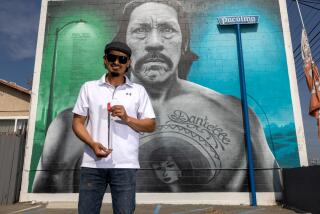Artist, Film Crew Argue Over Mural
It was bad enough that Noni Olabisi’s 40-foot mural of the Black Panthers set off a political controversy. It was worse that she never got paid the $5,000 she had once been promised for it.
And now, after finally completing the mural, Olabisi is locked in an argument with a cable TV movie crew that she says defaced the mural while shooting a scene for a movie about the 1992 Los Angeles riots.
The mural, which Olabisi painted over a period of a year on the side of a barbershop at Jefferson Boulevard and 11th Avenue west of downtown, was an attempt to illustrate the legacy of the Black Panthers.
After finishing the mural, Olabisi denied the producers of the movie “Riot” the right to use her mural as a background in a scene. She said she was offended by the shot, which she described as two African American men beating up a white man.
Lacking permission, the film crew covered up the mural. When workers removed the covering, sections of paint came off, Olabisi said.
“As far as I am concerned, they [defaced] it,” Olabisi said as she stood looking at her mural. “No consideration took place.”
*
As a result, a dedication ceremony celebrating the completion of the mural, scheduled for Saturday, has been turned into a rally in support of the artist. The rally will be held at the William Grant Still Arts Center in the Mid-City area.
The mural, called “To Protect and Serve: A Moment in African American History,” depicts the many facets of the Black Panthers, who were a lightning rod for black militancy in the 1960s civil rights movement. Inscribed is the slogan, “We want an immediate end to police brutality and murder of black people.”
On one side of the mural are images of violence against African Americans such as a lynching and a man being restrained by white police officers, images the Panthers used to justify their militancy. On the other side of the mural are portrayals of food giveaways and other social service programs sponsored by the Panthers.
In the middle is Panther leader
Huey Newton, shown clutching a rifle to his chest. The damage done to the mural includes two strips of paint that appear to have been torn from Newton’s nose and lips.
“Riot” is being produced by Rasta Productions, in association with Francis Ford Coppola’s American Zoetrope Co. It is to be aired on Showtime in 1997.
Producer Harry Winer said he was unaware of any damage.
*
“I know that when there wasn’t a possibility to get the rights to the mural, it was requested that we cover it up,” Winer said. “I know a lot of conscious care was used in order to protect it.” He said that if his company did damage the mural he would be happy to talk to Olabisi about it.
Although the damage done to the artwork is small in size, Olabisi said restoring the piece would be a major undertaking because she painted the mural in many layers. “I can’t just take a glob of paint to fix it,” she said. “It’s like you’ve got a hole in your sock. You can try to fix it but it will never be the same.”
Showtime spokesman Steven Rubin said the film company was not responsible and suggested that Olabisi had “some political reason” behind her allegations, such as attracting publicity or money. “I think it’s very ironic that the damage was on the very character [Huey Newton] who has become the controversial image,” he said.
Even before Olabisi put one stroke of paint on the wall, the mural was making waves.
The mural design was rejected three times by the city of Los Angeles’ Cultural Affairs
Department over a nine-month period before it was approved in October 1994. But by the end of the month, funding was withdrawn again after city officials pressured the art organization that hired Olabisi, Social and Public Art Resource Center, to drop her mural from its lineup or face losing the organization’s city funding.
*
The resource center reluctantly agreed, but started a Black Panther mural fund to help pay Olabisi and gave her scaffolding and paint so she could go ahead with the project. The organization was able to raise $1,275 for the artist, said assistant director Gail Schwartz.
Olabisi said she would like the filmmakers to pay for the damages, and she still hopes that the city will change its mind and pay her for her work.
More to Read
The biggest entertainment stories
Get our big stories about Hollywood, film, television, music, arts, culture and more right in your inbox as soon as they publish.
You may occasionally receive promotional content from the Los Angeles Times.










